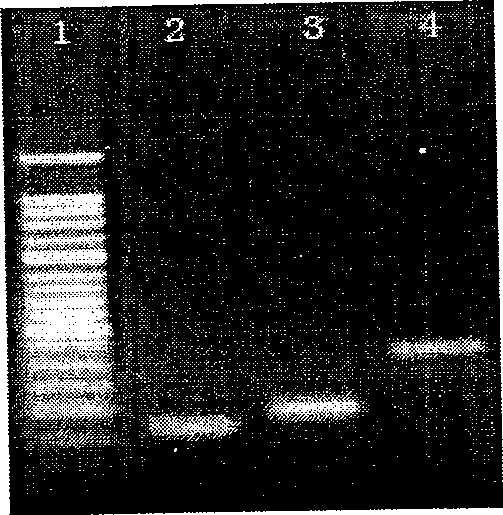Method for purifying small fragment DNA in gel by grinding method and use thereof
A grinding method and small fragment technology, applied in the field of molecular biology, can solve the problems of low recovery efficiency, failure to obtain, and failure to obtain target fragments, etc., and achieve the effect of improving recovery efficiency
- Summary
- Abstract
- Description
- Claims
- Application Information
AI Technical Summary
Problems solved by technology
Method used
Image
Examples
Embodiment 1
[0021] 1) Add 400 μl of 0.1 times TE buffer or sterilized water to the recovered high-concentration gel containing 70 bp DNA PCR products, grind and break with a homogenizer, centrifuge at 10,000 rpm for 10 minutes, and take the supernatant;
[0022] 2) Add 1 / 3 volume of 3M NaAc with a pH of 5.2 and 2 volumes of absolute ethanol, or 0.6 volumes of isopropanol to the supernatant to precipitate DNA; centrifuge at 10,000 rpm for 10 minutes, discard the supernatant;
[0023] 3) Wash the DNA pellet with 600 μl of 70% cold ethanol, centrifuge at 10,000 rpm for 5 minutes, and discard the supernatant;
[0024] 4) Vacuum-dry the DNA precipitate to evaporate the residual ethanol, dissolve the DNA precipitate in 0.1 times TE buffer or sterilized water, and store at -20°C. Take 5ul electrophoresis results as figure 1 shown.
Embodiment 2
[0026] 1) Add 800 μl of 0.1 times TE buffer or sterilized water to the recovered high-concentration gel containing 98bp DNA PCR products, grind and break with a homogenizer, centrifuge at 12,000 rpm for 5 minutes, and take the supernatant;
[0027] 2) Add 1 / 3 volume of 3M NaAc with a pH of 5.2 and 2 volumes of absolute ethanol, or 0.6 volumes of isopropanol to the supernatant to precipitate DNA; centrifuge at 12,000 rpm for 5 minutes, discard the supernatant;
[0028] 3) Wash the DNA pellet with 1000 μl of 70% cold ethanol, centrifuge at 12000 rpm for 3 minutes, and discard the supernatant;
[0029] 4) Vacuum-dry the DNA precipitate to evaporate the residual ethanol, dissolve the DNA precipitate in 0.1 times TE buffer or sterilized water, and store at -20°C. Take 5ul electrophoresis results as figure 1 shown.
Embodiment 3
[0031] 1) Add 600 μl of 0.1 times TE buffer or sterilized water to the recovered high-concentration gel containing the 225bp DNA fragment generated by enzyme digestion, grind and break with a homogenizer, centrifuge at 11,000 rpm for 6 minutes, and take the supernatant;
[0032] 2) Add 1 / 3 volume of 3M NaAc with a pH of 5.2 and 2 volumes of absolute ethanol, or 0.6 volumes of isopropanol to the supernatant to precipitate DNA; centrifuge at 11,000 rpm for 6 minutes, discard the supernatant;
[0033] 3) Wash the DNA pellet with 800 μl of 70% cold ethanol, centrifuge at 11,000 rpm for 6 minutes, and discard the supernatant;
[0034] 4) Vacuum-dry the DNA precipitate to evaporate the residual ethanol, dissolve the DNA precipitate in 0.1 times TE buffer or sterilized water, and store at -20°C. Take 5ul electrophoresis results as figure 1 shown.
PUM
 Login to View More
Login to View More Abstract
Description
Claims
Application Information
 Login to View More
Login to View More - R&D
- Intellectual Property
- Life Sciences
- Materials
- Tech Scout
- Unparalleled Data Quality
- Higher Quality Content
- 60% Fewer Hallucinations
Browse by: Latest US Patents, China's latest patents, Technical Efficacy Thesaurus, Application Domain, Technology Topic, Popular Technical Reports.
© 2025 PatSnap. All rights reserved.Legal|Privacy policy|Modern Slavery Act Transparency Statement|Sitemap|About US| Contact US: help@patsnap.com


